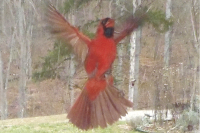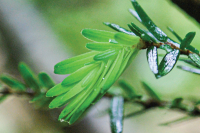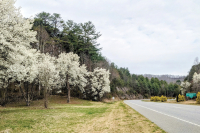Stalked by a not so wild elk
An old friend from Mer Rouge, La., George Bowe, was passing through a couple of weeks ago so we decided to take a ride down to Cataloochee and see if the elk were out. We got down to the valley around 3 p.m. and before we got to the Palmer Chapel we spotted elk, grazing and generally lounging around in the fields. It was apparent that the large bulls had already dropped their massive antlers but the young bulls with spikes and small 4-point racks still had antlers.
The elk were brought to the Great Smoky Mountains National Park in two groups in early 2001. The first batch of 25 elk from Land Between the Lakes on the Tennessee-Kentucky border was released in 2001. In 2002, another 27 elk from Elk Island National Park in Alberta, Canada were released into the valley. Original reintroduction plans called for a third release, but North Carolina Wildlife Resources Commission decided that was too risky (they feared chronic wasting and/or other diseases might be transferred to local deer and/or cattle populations) and the Park Service nixed the last release.
Biologists in neighboring states don’t appear gripped by the same fears. Kentucky estimates its elk population at nearly 10,000 now. About 1,500 elk were released in Kentucky between 1997 and 2002. Tennessee has seen its 200 reintroduced elk (between 2000 and 2008) double in population and Virginia has plans to release hundreds of elk into the southwestern corner of the state this year.
The original reintroduction in the Smokies was billed as a 5-year experimental release during which time the impacts “on” the elk and “of” the elk would be studied and a determination would be made regarding the herd’s status. Because of the inability to release more elk, the study period was extended for three years. The Park Service changed the status of the elk in Cataloochee, early in 2010, from experimental to an official reintroduction. The herd has grown to between 130 and 140 animals at this point.
I was fortunate enough to get to go to Land Between the Lakes back in 2000 when the original elk were rounded up for the trip to the Park. Kim Delozier and his crew were quite professional and the capture went smoothly. However, it was apparent that these elk that lived in a 700-acre fenced-in enclosure were not the wild and wily beasts of the forests and prairies of the West, alert to every movement and/or scent that came their way; prepared to bolt for safety at a moment’s notice.
And the elk George and I found the other day at Cataloochee appeared to have a healthy dose of those genes. After we passed the Palmer Chapel we saw elk again in the front yard of the old Caldwell house. We drove on down to the end of the road and upon seeing no more elk in the fields, we returned to the Caldwell house.
There were a couple of elk (looked like a cow and calf) still grazing in the yard. We got out to get some photos and more elk came from behind the house.
I wanted to show George the old house so we started across the footbridge figuring the elk would mosey on. Well, they moseyed — only toward us, not away, so we returned to the road. Then about four young bulls came out of the woods and into the yard. A couple decided to practice their sparring moves.
Next, the whole group waded into the stream for a drink. And a really curious cow and calf started towards us. We didn’t want to run afoul of any of the Park’s elk protocol, so we retreated to the truck. The cow and calf came right up and started nosing the back hatch of my white Montero. Made me wonder if the Park Service had done any supplemental feeding during the snow and nasty weather this winter from white, Park Service vehicles or if maybe unthinking visitors have actually been feeding them.
Whatever the reason, it’s certainly not good to have 1,000-pound animals that acclimated to humans — they could present a danger to unsuspecting visitors. But more sadly, fed elk can be just as dead as fed bears.
Don Hendershot can be reached at This email address is being protected from spambots. You need JavaScript enabled to view it.
Cataloochee Elk deemed a success
But a decade after the first elk hoof hit the soil of Cataloochee Valley, the National Park Service is ready to declare the elk project a success and designate the species as an “official” reintroduction.
The elk have grown from an initial 50 to an estimated 134 animals. Aside from the logistical nightmare of trying to find and remove them all, the park service would have been the target of public firestorm if it decided to do away with the elk at this point.
“I have never seen the ownership that people have shown toward these species,” said Kim Delozier, the Smokies’ lead wildlife biologist. “They are a large animal, a majestic animal and symbol of wilderness, and we tend to gravitate toward those things.”
The official designation as a reintroduced species means the elk, which were hunted to extinction in the Southern Appalachians in the 1800s, are back for good.
If their numbers keep growing, elk may one day roam widely across the mountains again. Kentucky and Tennessee have reintroduced elk as well, and Virginia announced just last month that it will follow suit.
“I would like to see elk throughout the Appalachian chain,” said Joe Treadway, a founding member of the Smokies chapter of the Rocky Mountain Elk Foundation and an early advocate for the reintroduction. “Will I see it in my lifetime? Maybe not, but I certainly hope my son and grandson will.”
The change in the elk’s status from an “experimental release” to an “official reintroduction” is rewarding, Treadway said. And it’s more than just semantics.
“It allows us to get together and develop a serious long-term management plan that to this point we have not had,” Treadway said.
Treadway, along with many in the Elk Foundation who supported the reintroduction, hope to hunt elk one day. Elk can never be hunted in the park, but Treadway hopes they will disperse into the national forests and state gamelands and that the population will grow enough to make hunting viable.
Under the new designation, elk that wander out of the park will be free to go their own way.
Before, the park would round elk up and bring them back if they roamed too far afield, into areas the park had declared early on as “no elk” zones. One elk was retrieved from Hot Springs. Another even made it to Glenville, a community near Cashiers, where it had taken up residence on a Christmas tree farm alongside a couple of domesticated reindeer.
Under the new plan, those elk would be left alone to make their home where they pleased.
Elk that wandered only a little bit outside the park had always been given a free pass unless the landowner complained. Delozier said the park rarely got complaints from neighboring property owners.
“Most people loved them. They think they are the greatest thing since sliced bread,” Delozier said.
Some wouldn’t let the park come on their property to retrieve an elk even if the park wanted to.
If a park neighbor did complain about a stray elk, however, park rangers would go get it. Under the new designation, the park will no longer do so as a matter of course.
“The change is now we will not take the lead. The state will take the lead on dealing with elk calls,” said Delozier.
Delozier said the park service will help the state Wildlife Commission with calls about nuisance elk if requested.
Exactly how the state will deal with the new species isn’t known. It has not yet developed a management plan for elk.
In anticipation of the park service backing away from oversight of the elk, the Wildlife Commission proposed a status change earlier this year that would make it legal for landowners to shoot an elk if it was causing property damage.
The Wildlife Commission said it didn’t have the time or resources to police elk run-ins once the park stopped doing so. But public outcry led the Wildlife Commission to drop the proposed change in status.
When elk were released in 2000, there were a few naysayers. Some feared they would bring diseases with them that could spread to deer or even cattle. Farmers worried elk would get into their crops. Some worried they would overpopulate. Others simply doubted the elk would make it.
So far, none of the fears have come to fruition, Delozier said.
Still others claimed the elk would be easy targets for poachers. But only two elk have been shot.
One was maliciously targeted inside the park by a poacher, who was ultimately caught. The other was killed at the hands of a dairy farmer in Jonathan Creek, a community bordering Cataloochee Valley. An elk had repeatedly come onto his farm and eaten the cattle’s food. He called the park and told them he would be shooting the elk.
One elk prediction that hasn’t come true, at least not yet, has proved disappointing. Park rangers hoped that elk would migrate to some of the high grassy balds where continual grazing would help keep them open. The Southern Appalachians were once home to numerous high grassy balds, but most have been overtaken by trees and bushes in recent decades. The park has lost several of its former grassy balds. Two that are still left — Andrews and Gregory balds — are mowed to keep the forest from encroaching.
Delozier said if the elk stumbled upon the balds, they would likely take up residence there and keep them maintained. But the elk population has not grown enough yet to disperse throughout the park.
Hunting elk
Right now, elk are designated a non-game animal by the state, so it is illegal to shoot one even outside the national park boundary.
In Kentucky — where 1,500 elk were released between 1997 and 2002 — the population now numbers close to 10,000. A limited number of elk hunting permits are given out each year through a lottery system. This year, 40,000 applied for one of only 850 elk tags. Each person who applies forks over a $10 fee that goes to the state wildlife agency.
In Tennessee, an auction for one of its elk hunting tags in 2009 went for $17,000 on eBay.
Tennessee released 200 elk between 2000 and 2008, and now has a population of around 400. It held a lottery for just five hunting tags last year — a token number given the still small population.
Virginia plans to release several hundred elk in three mountain counties in the southwest corner of the state next year.
Tennessee and Kentucky — and soon Virginia — all have larger herds than North Carolina since they brought in more animals to start with. Unlike the other three states, however, North Carolina has indefinitely halted the release of any more elk.
The rule was put in place by the N.C. Wildlife Commission because it feared an elk could be carrying chronic wasting disease, a deadly and contagious illness that can infect any hoofed animal, including deer or cattle.
That stopped the Smokies from bringing in additional elk, and the park’s herd has been hamstrung as a result. For a few years, the numbers seemed touch and go. Black bears were eating so many elk calves that the herd was barely reproducing enough to replace those that died from natural causes.
But the herd finally got over that hump, thanks to a little help from park rangers who took to moving the black bears out of Cataloochee Valley during calving season.
This year, no bears were moved, and the herd still saw roughly 25 calves survive.
It bothers advocates of the herd that additional releases can’t take place.
“You have to worry about the long-term genetic pool, with the lack of genetic diversity can they grow and prosper like they need to?” Treadway said.
Give your two-cents
The National Park Service is seeking public comment on the long-range plan for managing the elk herd in the Smokies. To comment, go to parkplanning.nps.gov/grsm. Deadline is Sept. 27.
To read a copy of the environmental report on how elk have adapted to the Smokies and their long-term outlook, go to the outdoors page at www.smokymountainnews.com and click on this story.
Species comebacks in the Smokies
There have been several successful reintroductions in the Smokies, including river otter and peregrine falcons.
Only one has ever failed. A pack of red wolves released in Cades Cove were unable to make it, mostly due to competition from coyotes, which had filled the top predator niche once dominated by the wolves. Seven years after their release, the few wolves that had managed to hang on were removed and the project terminated.
Elk will now join the list of successful reintroductions in the park’s book.
“The reintroduction of the elk is another success story of increasing biodiversity in the park, like the peregrine falcon, as well as the continuing efforts to restore the brook trout,” said Holly Demuth, North Carolina director of Friends of the Smokies. “The viability of the coalescing elk herd shows that the park is a great refuge for wildlife.”
Smokies not pleased with Wildlife Commission stance on elk
The North Carolina Wildlife Commission is at odds with the Great Smoky Mountains National Park over the status of the newly reintroduced elk herd.
The N.C. Wildlife Commission has come under fire for its plan to remove elk from the state list of species of special concern. As it scrambles to defend the delisting, the wildlife commission is pointing to a change in the herd’s status by the national park as the reason.
“From a biological perspective, with the information from the park we’ve gotten indicating they’ll declare the elk reintroduction a success, it means we don’t need to protect them with the special status,” said David Cobb, chief of the wildlife management division for the North Carolina Department of Environment and Natural Resources.
But that’s not exactly right, according to Bob Miller, a spokesperson for the Smokies. Miller said the park has not yet categorized the reintroduction of elk a success.
“We never told them the reintroduction program was a success,” Miller said. “What we told them is we have a population that is stable barring some kind of disaster or human intervention.”
The park does plan to change the herd’s status from an “experimental release” to an official “reintroduction” later this year. Under the experimental release status, the park was monitoring the herd closely to see whether they were a good fit for the ecosystem. The shift to an official “reintroduction” is different from declaring it a success, however.
Elk were reintroduced to the Cataloochee area of the Great Smoky Mountains National Park in 2001. Since then the initial herd of 52 animals has grown in size to 110 animals.
Miller said the park would submit a formal letter clarifying its position to the Wildlife Commission before the end of the public comment period.
Elk delisting draws ire of protectors
“Elk don’t know how many feet a horse has.”
That’s the advice Bear Claw Chris Lapp gave Jeremiah Johnson as the pair hid behind their horses while stalking elk in the eponymous Robert Redford film. Well, according to Jackson County Commissioner Tom Massie, elk don’t know the boundaries of the Great Smoky Mountain National Park either.
“I truly believe we need an elk management plan because the population will continue to grow and the elk don’t recognize the boundaries of Smoky Mountain National Park,” said Massie, representing the North Carolina Wildlife Federation.
While elk are protected inside the park’s boundary, they could lose their status as a species of special concern when wandering onto private property under a proposed change by the N.C. Wildlife Commission.
Hunting elk would still be illegal but private landowners could shoot elk causing property damage. Under the current rules, landowners are supposed to get a permit before shooting problem elk.
Massie was one of a host of people who turned out at a public hearing in Sylva last week on the rule change. With a herd population of only 110, the loss of even a few elk at the hands of careless private landowners could jeopardize their long-term viability, according to opponents of the rule change.
Bob Miller, a spokesperson for the Smokies, said that over a third of the herd now lives outside the park’s boundaries in Haywood County and the Cherokee Reservation.
David Cobb, chief of the wildlife management division for the North Carolina Department of Environment and Natural Resources, said he had no way of knowing what the death of even a few elk would have on the herd.
“I can’t say what the death of one elk would do because I haven’t done the population study,” Cobb said.
Massie called on the N.C. Wildlife Commission to establish a management plan for the elk, something the state currently lacks.
Brad Howard, a wildlife biologist with the N.C. Wildlife Resources Commission, said elk will essentially still be protected even though they won’t have special concern status.
“People seem to be concerned that people will start shooting elk at leisure,” Howard said. “That is not the case. Our enforcement guys are going to want to know why you shot this elk and show us the property damage that warrants why you shot this elk. There are very specific parameters and you have to justify the animal was in fact doing damage.”
Dan McCoy, former tribal chairperson of the ECBI, traveled to the meeting with his son Connor to speak up for the elk. McCoy told commissioners he’d purchased the boy a lifetime membership to the Rocky Mountain Elk Foundation in the hopes that one day he would be able to hunt the animals.
“Our people are proud of these elk. They’re proud they’re there, but they still need our protection,” he said.
People who have put their time and money into establishing a healthy elk herd in Western North Carolina are demanding that the animals retain their status as a species of special concern.
“Listen to the hearts and minds of the people on this because that’s really what this is all about,” Ramona Bryson said.
The Rocky Mountain Elk Foundation and Friends of the Smokies led a massive fundraising effort that garnered over $1.2 million to support the reintroduction project. A satellite herd has taken up residence on land owned by the Eastern Band of Cherokee Indians, contributing to the sentiment that the N.C. Wildlife Commission is not the only stakeholder in the debate over the animals’ future.
Ray Bryson, another member of the Rocky Mountain Elk Foundation, was one of the volunteers who drove 59 hours round trip to Alberta, Canada, to deliver the elk to the park when the herd was first established. Bryson urged the Wildlife Commission to work with the national park and the tribe to establish a management plan that would expand the elks’ range into the Pisgah and Nantahala national forests.
Cobb said his staff met with members of the Rocky Mountain Elk Foundation in person before the hearing and the discussion concerning their protected status is ongoing.
“This is nowhere close to a done deal,” said Cobb.
Elk could be booted from state species of special concern list
Elk could lose their status as a species of special concern under a new rule change proposed by the N.C. Wildlife Commission.
A public hearing on proposed changes to state hunting and fishing rules will be held at 7 p.m. Wednesday, Jan. 13, at Southwestern Community College in Sylva. Organizations that provided financial support for the reintroduction of the elk are prepared to speak out against the proposed rule change.
It is illegal to shoot an elk — both inside the national park boundaries and outside the park. Despite a delisting as a species of special concern, elk would retain their status as a “non-game” animal, making hunting them illegal even if they wander outside protected national park lands.
Tom Massie of Jackson County said the proposal is causing a great deal of confusion, however, and questioned the rationale behind it.
“There have been a lot of people who have spent a lot of time and effort and money to get the elk herd reestablished,” Massie said. “It is a huge economic draw for this region of the state. Why even do it right now?”
Massie said he would like to see the state do a management plan for the species to compliment the national park’s management plan. Elk are frequently wandering out of the park and are beginning to establish satellite herds.
The Wildlife Commission cites the success of the elk restoration project and growth of the herd, which makes the listing no longer necessary.
“This is primarily an administrative change,” said Brad Howard, private lands program coordinator for the Wildlife Commission. “There is no documented evidence we need to have a special concern status on the elk species right now.”
Howard said the move will mirror the national park’s change in status expected later this year, which will shift from “experimental release” to an official “reintroduction.”
“The park has said ‘OK it worked. Let’s see if this population will sustain itself in Western North Carolina,’” Howard said.
Hunting, fishing regs undergo annual review
Every year, the N.C. Wildlife Resources Commission suggests adjustments to their regulations to accommodate hunters and fishermen while protecting natural resources.
Public input can be made at one of nine hearings held statewide, including one at 7 p.m. Wednesday, Jan. 13, at Southwestern Community College in Sylva, or in writing.
Go to www.ncwildlife.org and click on submit comments online. Scroll down to see the list of proposed changes and click to comment. The deadline to comment is Jan. 22.
After collecting and considering all public comments, the Wildlife Commission will meet in March to decide whether or not to adopt the proposals.
Hunting
• Elk — Proposal would remove elk from the list of species of Special Concern. The only elk in the state are found in the Great Smoky Mountains National Park after being reintroduced to the park. Hunting elk would still be illegal within the park.
• Bobcat and otter — Trappers would no longer have to get tags for bobcat and otters they intend to sell. The U.S. Fish and Wildlife Service is no longer requiring tags for bobcats and otter being sold for commercial purposes, so the state wildlife commission aims to follow suit.
• Armadillo — While armadillo aren’t native to North Carolina, they are beginning to crop up and are being considered a nuisance by the wildlife commission. There is no game law that applies to armadillos, and this proposal aims to set up a year-round open season on armadillos with no bag limits.
Fishing proposals
• Franks Creek in Graham County — Proposal would end stocking and ban use of live bait under a new designation as Wild Trout/Natural Bait waters.
• Tellico River in Cherokee County — Proposal would ban use of natural bait and allow artificial lures only under new designation of Wild Trout waters.
• Nantahala River and tributaries in Macon and Clay counties upstream of Nantahala Lake — Proposal would end the exemption that allows fishing during closed season on hatchery supported waters.
• West Fork Pigeon River in Haywood County — Proposal would end stocking on the upper 3.7 miles of currently Hatchery-Supported waters and re-designate as Wild Trout Waters, which would ban live or natural bait, lower the daily limit from 7 to 4, and impose a minimum catch size of 7 inches. The change will better protect the wild brown trout population. The lower 1.7 miles will remain Hatchery-Supported Trout Waters.
• French Broad River — Proposal would decrease the size limit on muskies from 46 inches to 42 inches. Regulation dovetails with statewide rule change to set minimum size limit on muskies at 42 inches and one fish daily catch limit.
The move will conserve spawning stock by protecting 4- to 5-year-old sexually mature fish.
Smokies elk shot down in Cataloochee Valley
A man has been arrested for shooting an elk in the Great Smoky Mountains National Park last Friday.
The elk was shot around 10:30 a.m. in Cataloochee Valley. Another park visitor who happened to be in the area got a description of the man’s vehicle and license plate number, which was used to track down the vehicle’s owner.
A Special Agent with the National Park Service who was assigned to the case drove to the man’s house, five hours away in Granville County, N.C., and confronted him. The suspect reportedly confessed to the offense, according to a press release issued by the Smokies.
The Smokies elk herd is well-loved, even revered. The news has been hard to take for many elk fans who make regular trips to Cataloochee to watch and observe the herd.
Esther Blakely, a volunteer with the Elk Bugle Corp who sees the elk every week, was shocked when she heard the news.
“It is just sad,” Blakely said. “I am still having trouble wrapping my head around someone going into the national park, in this peaceful valley, and shooting this magnificent animal. These are protected animals. This is not a hunting ground. It is a national park.”
Elk once roamed the Smokies but were hunted to extinction in the 1800s. In the eight years since, 52 elk were reintroduced in the park.
This is the first incident of an elk being shot in the park.
“The many visitors and volunteers who come to Cataloochee expressly to watch the elk constitute a very effective surveillance network, which has undoubtedly prevented elk poaching from occurring earlier,” said Steve Kloster, Acting Chief Ranger.
While Cataloochee is certainly a popular destination, it would have been far from crowded at that time of morning on a weekday outside of peak tourist season. The sound of a gunshot reverberating throughout the valley would have sent up a red flag to anyone who was in the area. It is currently illegal to have a loaded and accessible firearm in a national park.
“Having a loaded weapon in the park would have been a violation in its own right,” said Bob Miller, a spokesperson for the park.
The bull elk, which was sporting an impressive antler rack, was left lying in the field at the edge of the woodline where it had been shot. A bull elk can weigh up to 800 pounds. Rangers took the dead elk to the University of Tennessee College of Veterinary Medicine for a necropsy, which is still pending.
Smokies rangers, the NPS Special Agent and the N.C. Wildlife Resources Commission cooperated on the investigation. The Park is now working with the U.S. Attorney’s Office to develop the case. The suspect’s name will be released once they figure out all the charges against him.
Those convicted of poaching in a national park can face up to six months in jail and/or a fine of up to $5,000. The weapon and the vehicle used in the crime also can be seized.
The loss of the bull will not negatively affect the long-term viability of the herd, which now numbers 105, but it is an affront what national parks embody.
“We do see this as a very serious theft of the public’s enjoyment of their national park,” Kloster said. “Thousands of visitors come to see these elk each year, and many of them know each animal by sight.”
Miller said elk fans are taking the loss quite personally. The elk that was shot, known as #21, was particularly well-loved.
“He is one of the largest, most magnificent dominant bulls in the valley,” Blakely said.
Only a few bulls are considered dominant. The bulls jockey for their dominant position during the mating season, known as the rut, which occurs in early fall. Dominant bulls emerge from the rut with a harem.
The bull that was shot would have already bred with the females in his harem by now. The bull is no longer crucial to the success of his harem after mating.
Visitation is up in Cataloochee so far this year, with more than 80,000 visitors for the year so far. Last year saw only 75,000. The Bugle Corp has 82 volunteers who take turns educating visitors about the elk and ethical wildlife viewing.
Antlers born anew
By Joe Yarkovich
Spring is upon us and with the days beginning to lengthen, signs of the season can be seen within the elk of Cataloochee as well.
Tis the elk rutting season
The shorter days and cooling temperatures of September and October were an important time of the year for the elk of Cataloochee: the fall rut. The rut is the several-week breeding period when the cows cycle into estrus and the bulls compete for dominance to mate with the cows.
Elk population on the rise
The elk herd in Cataloochee Valley added at least eight babies to its ranks this summer, giving the herd a needed population boost.
Since the elk herd was released in the Great Smoky Mountains National Park five years ago, black bears have become adept at scooping up the infant elk in the early weeks after their birth. The number of elk calves who survived each year were just enough to replace adult elk who died, keeping the herd’s numbers around a constant 50.
Elk negotiations continue
Dick Hamilton, director of the North Carolina Wildlife Commission, is stuck between a rock and a hard place.
Biologists with the Great Smoky Mountains National Park want to increase the elk herd in Cataloochee by bringing in a new batch of elk from Kentucky.









